This article was co-authored by Pippa Elliott, MRCVS. Dr. Elliott, BVMS, MRCVS is a veterinarian with over 30 years of experience in veterinary surgery and companion animal practice. She graduated from the University of Glasgow in 1987 with a degree in veterinary medicine and surgery. She has worked at the same animal clinic in her hometown for over 20 years.
There are 10 references cited in this article, which can be found at the bottom of the page.
wikiHow marks an article as reader-approved once it receives enough positive feedback. In this case, 100% of readers who voted found the article helpful, earning it our reader-approved status.
This article has been viewed 74,245 times.
Cleaning your cat's teeth should be an important part of the grooming routine. Brushing your cat's teeth with a special pet-designed toothbrush and toothpaste removes plaque and bacteria that can grow in the mouth and have adverse effects on your pet's oral and overall health. It might be difficult to clean the teeth of an adult cat that is not used to the process. However, after a few practice sessions, both you and your cat should get used to it. Strive to brush your cat's teeth daily (or at least weekly) to promote healthy teeth and gums.
Steps
Preparing for a Teeth Cleaning
-
1Visit the vet. A veterinarian will be able to confirm whether or not your cat has a buildup of plaque or tartar. Plaque can be cleaned away by brushing, but eliminating the buildup of tartar requires the use of special tools and can only be done in a vet’s office. [1]
- Also, your vet can assess the overall oral health of your cat and should be able to tell you if it is safe to brush the animal’s teeth.
- Your vet should also be able to recommend oral health care products that will be safe and effective for your cat.
-
2Purchase your supplies. Your basic supplies will include a soft bristled pet toothbrush and a pet-safe toothpaste. You can’t use human toothpaste on a cat as the fluoride in the toothpaste is toxic to them. You will also need a cat toothbrush.[2]
- Any toothpaste with xylitol (a sweetener) can be deadly to a cat.
- Cat toothbrushes can will either be a fingertip type (one you slip over your fingertip) or one that looks like a child-sized toothbrush that is specifically designed for a cat’s mouth.
- You can actually buy a pet dental kit, including the right toothpaste and toothbrush, at a pet store or from your vet.
Advertisement -
3Acclimate your cat to the toothpaste. Introduce the tooth brushing slowly, ideally over a few days. This can help your cat stay relaxed and know what to expect so he won't be scared and is less likely to struggle.[3]
- To start, put a little bit of the pet toothpaste on your fingertip and let your cat lick it off. The next day, do the same and then run your finger along the gums of your cat’s upper teeth. The following day, put the toothpaste on the toothbrush and let your cat lick it off.
- Cats, like people, have flavor preferences. To make your brushing session go as smoothly as possible, it may be wise to buy multiple types of toothpaste to see if there is one your cat may prefer over another.
-
4Acclimate your cat to the toothbrush. Allowing the cat to interact with the toothbrush prior to cleaning his teeth will allow him to be more comfortable around the device. Most cats will rub their cheeks and gums along the surface of objects to mark it with their scent, essentially claiming it as their own.
- Let your cat mark the toothbrush as his and get him used to having it around his mouth before you try to use it in his mouth. Allowing him access to the brush at least once a day for twenty minutes for two to three days beforehand should allow him to become more comfortable with the cleaning apparatus before use.
- If you have more than one cat, be sure that each individual animal has his or her own toothbrush and do not use the same toothbrush on multiple cats.
-
5Reward your cat for positive interactions. While acclimating your cat to the toothbrush and toothpaste, be sure to reward him with small treats or a favorite toy after he has interacted with the tooth cleaning devices.
- If your cat seems reluctant or fearful of the toothbrush or toothpaste, do not give him a treat, as this can reinforce negative interactions with the toothbrush and toothpaste.
Cleaning Your Cat's Teeth
-
1Place your cat on a comfortable surface. This can help your cat relax while you clean his teeth. If you know your cat likes to struggle, try wrapping him in a towel to keep him from scratching or trying to escape.
- It should take you less than 30 seconds to brush your cat's teeth.
- It is also wise to wear long sleeves or even gloves if your cat is likely to struggle or will try to escape the cleaning.
-
2Brush your cat's teeth. You should have already given your cat two to three days to get used to the toothpaste. On the fourth day, apply the toothpaste on the brush and try brushing a few of the teeth.
- Repeat this daily until your cat lets you run the toothbrush gently along the gum and teeth. Work the bristles of the brush along the gum line of the upper back teeth and angle slightly up, so the bristles get under the gum line.
-
3Make circles along the gum line. Once your cat is fine with the routine described in the previous step, start to make small circles along the gum line working from back to front, massaging the gums.[4]
-
4Brush regularly. Make sure to repeat the routine on a daily basis- or at least a few times a week- to ensure your cat’s mouth will be the healthiest it can be. While brushing reduces the plaque and buildup on the visible surfaces of the teeth, it cannot reach the buildup just under the gum line. But every time you brush you greatly reduce the amount of plaque and bacterial buildup in your cat’s mouth.[5]
-
5Check for any problems. While brushing your cat's teeth, do a quick scan of his mouth to see if there is anything that needs further attention from a vet. For example, bleeding gums are a sign your cat needs professional dental scaling by your veterinarian, so take care of that as soon as possible. Pus, lumps, sores, red areas, and loose teeth in your cat's mouth should also be inspected by a vet. [6]
Choosing an Alternative Method to Brushing
-
1Know your cat's tendencies and pair treatments. Certain cats simply will not allow you to brush their teeth at home on a daily or bi-weekly basis. If your cat won't allow the brushing process to happen, you can try coupling the treatments listed below with more regular visits to your vet for professional cleaning.
- You should know that oral health treats, toys, additives or foods are not a substitute for daily brushing.
- Also, if your cat experiences a high or unusual amount of the stress when taken to the vet, you will need to consider this in relation to the stress your cat causes you during the brushing process.
-
2Use “special” food. There are some foods and cat treats that are specifically formulated to help “grind” the plaque off of cats' teeth. Generally the kibble is formed so that it has a rougher texture. As the cat chews, this surface wears away the plaque.[7]
- Look for food labeled “dental care” or “tooth care” when purchasing a food designed to control plaque. These foods won’t work if there is already tartar on the teeth. This will need to be removed by a dental cleaning prior to starting the food. You should talk to your vet before trying this type of food with your cat as there can be conditions under which cats should not eat this food (including mouth pain, kidney disease, etc.).
-
3Use dental additives or sprays. There are additives that can be added to water which will reduce the amount of bacteria in your cat's mouth. Some of these products also come in a spray bottle so you can apply them directly to the teeth.[8]
- Check with your veterinarian if these additives would be beneficial to your cat and if your cat has any existing medical conditions.
- These products can't remove tartar from teeth but instead control the amount of bacteria in the cat's mouth.
-
4Use cat toys. You can also buy netted chewable cat toys that clean your cat's teeth, remove soft tartar, and massage his gums all while keeping him entertained. Cats have a natural inclination to chew so you might as well provide him with something to chew on that also enhances teeth strength and dental health at the same time.
-
5Get a professional cleaning. Even with regular tooth brushing, there will be those cats that will need an occasional professional cleaning (just like some people have to go to the dentist more frequently than others). If tartar begins to accumulate along the gum lines, it’s time for a dental cleaning.[9]
- Tartar will appear as a light tan substance on the teeth along the gum lines. As it keeps accumulating, it will become a thicker layer darkening to a darker brown or sometimes grey.
Understanding Why You Should Clean Your Cat's Teeth
-
1Know the difference between plaque and tartar. Bacteria in your cat's mouth forms plaque, which sticks to the surface of your cat's teeth. If this bacteria-laden plaque is not removed by a good brushing, it begins to mineralize into tartar, a substance that essentially cements to the teeth and can only be removed by dental scaling at the vet's office.[10]
- There are a number of conditions that can develop if you don't properly care for your cat's oral hygiene, so keep a close eye on plaque and tartar buildup.
-
2Identify gingivitis. Gingivitis is an inflammation of the gums which appears as a dark red line along the gum/tooth line. Just like in humans, gingivitis is a sign of poor dental health and needs to be addressed by a veterinarian before it becomes a more serious problem. [11]
-
3Know the signs of periodontitis. This is caused when gingivitis is left untreated. Periodontitis develops deep below the gum line and infects the tooth socket. This can cause painful abscesses and loosen the teeth.[12]
-
4Look for mouth ulcers. When gingivitis goes untreated, painful mouth ulcers can occur. These will appear as bright red sores in the cat’s mouth. Oftentimes, these ulcers will bleed. [13]
-
5Identify rodent ulcers. Rodent ulcers look similar to mouth ulcers, but the sore or swelling will form on the cat’s upper lip.[14]
-
6Look for signs of stomatitis. Stomatitis is an incredibly painful inflammation of the mouth. The cat will have a lot of trouble eating or even refuse to eat. The inside of the mouth will appear reddened and raw.
- In addition, there are a number of conditions that can develop if you don't properly care for your cat's oral hygiene.
-
7Be aware of other medical conditions. There is mounting evidence that various body organs can be affected by the bacteria and toxins which can travel from the mouth to the body via the bloodstream. Chronic inflammation in the mouth can contribute to problems, such as elevated liver enzymes, heart disease, kidney disease and diabetes.[15]
Expert Q&A
-
QuestionHow much does it cost to clean a cat's teeth?
 Pippa Elliott, MRCVSDr. Elliott, BVMS, MRCVS is a veterinarian with over 30 years of experience in veterinary surgery and companion animal practice. She graduated from the University of Glasgow in 1987 with a degree in veterinary medicine and surgery. She has worked at the same animal clinic in her hometown for over 20 years.
Pippa Elliott, MRCVSDr. Elliott, BVMS, MRCVS is a veterinarian with over 30 years of experience in veterinary surgery and companion animal practice. She graduated from the University of Glasgow in 1987 with a degree in veterinary medicine and surgery. She has worked at the same animal clinic in her hometown for over 20 years.
Veterinarian Expect to pay a minimum of $100 but often up to $250 for a basic descale. This can be a costly procedure because it requires a general anesthetic. If the cat is older (it's often elderly cats that have very dirty teeth), then pre-anesthetic screening may be needed, too, ahead of the anesthetic. Some patients also require intravenous fluids to support them during the procedure.
Expect to pay a minimum of $100 but often up to $250 for a basic descale. This can be a costly procedure because it requires a general anesthetic. If the cat is older (it's often elderly cats that have very dirty teeth), then pre-anesthetic screening may be needed, too, ahead of the anesthetic. Some patients also require intravenous fluids to support them during the procedure. -
QuestionHow long does it take to clean a cat's teeth?
 Pippa Elliott, MRCVSDr. Elliott, BVMS, MRCVS is a veterinarian with over 30 years of experience in veterinary surgery and companion animal practice. She graduated from the University of Glasgow in 1987 with a degree in veterinary medicine and surgery. She has worked at the same animal clinic in her hometown for over 20 years.
Pippa Elliott, MRCVSDr. Elliott, BVMS, MRCVS is a veterinarian with over 30 years of experience in veterinary surgery and companion animal practice. She graduated from the University of Glasgow in 1987 with a degree in veterinary medicine and surgery. She has worked at the same animal clinic in her hometown for over 20 years.
Veterinarian An average time for a descale under anesthesia is around 20 minutes. However, if extractions are required, it can take anywhere from 30 minutes to two hours.
An average time for a descale under anesthesia is around 20 minutes. However, if extractions are required, it can take anywhere from 30 minutes to two hours. -
QuestionHow often do you need to brush your cat's teeth?
 Pippa Elliott, MRCVSDr. Elliott, BVMS, MRCVS is a veterinarian with over 30 years of experience in veterinary surgery and companion animal practice. She graduated from the University of Glasgow in 1987 with a degree in veterinary medicine and surgery. She has worked at the same animal clinic in her hometown for over 20 years.
Pippa Elliott, MRCVSDr. Elliott, BVMS, MRCVS is a veterinarian with over 30 years of experience in veterinary surgery and companion animal practice. She graduated from the University of Glasgow in 1987 with a degree in veterinary medicine and surgery. She has worked at the same animal clinic in her hometown for over 20 years.
Veterinarian A cat's teeth should be brushed once a day. Not doing so increases the risk of plaque accumulating, which hardens and becomes tartar.
A cat's teeth should be brushed once a day. Not doing so increases the risk of plaque accumulating, which hardens and becomes tartar.
Warnings
- Make sure to have your vet check your cat's teeth during every annual checkup.⧼thumbs_response⧽
References
- ↑ https://www.aspca.org/pet-care/cat-care/cat-grooming-tips
- ↑ https://www.banfield.com/Wellness-at-banfield/Dental-care/How-to-brush-dog-and-cat-teeth
- ↑ https://www.vet.cornell.edu/departments-centers-and-institutes/cornell-feline-health-center/health-information/feline-health-topics/feline-dental-disease
- ↑ https://www.vet.cornell.edu/departments-centers-and-institutes/cornell-feline-health-center/health-information/feline-health-topics/feline-dental-disease
- ↑ https://www.banfield.com/Wellness-at-banfield/Dental-care/How-to-brush-dog-and-cat-teeth
- ↑ https://www.indiantrailanimalhospital.com/services/cats/cat-dental-care
- ↑ http://www.vohc.org/accepted_products.htm
- ↑ https://www.scottsdalecatclinic.com/blog/at-home-cat-dental-care-tips/
- ↑ https://vcahospitals.com/know-your-pet/dental-cleaning-in-cats
- ↑ https://www.rspcapetinsurance.org.au/pet-care/cat-care/guide-to-cat-dental-care
- ↑ https://www.aspca.org/pet-care/cat-care/cat-grooming-tips
- ↑ https://www.rspcapetinsurance.org.au/pet-care/cat-care/guide-to-cat-dental-care
- ↑ Textbook of Small Animal Surgery, Volume 1. Douglas H. Slatter. Elsevier Health Sciences, 2003
- ↑ Textbook of Small Animal Surgery, Volume 1. Douglas H. Slatter. Elsevier Health Sciences, 2003
- ↑ https://www.mouthhealthy.org/~/media/ADA/Publications/Files/patient_61.ashx
About This Article
To clean a cat's teeth, you'll need a soft-bristled pet toothbrush and some pet-safe toothpaste. Before you brush your cat's teeth, spend a few days acclimating it to the toothpaste by letting it lick some off your fingers and the toothbrush. You should also let your cat inspect the toothbrush every day for a few days so it's comfortable with it. Then, after a few days, wrap your cat in a towel in case it tries to struggle, and brush its teeth with the special toothbrush and toothpaste. For more tips from our Veterinary co-author, like how to clean your cat's teeth without brushing them, read on!
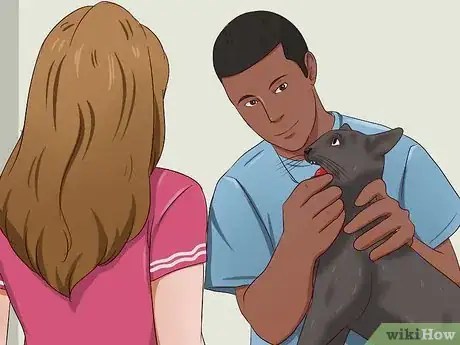
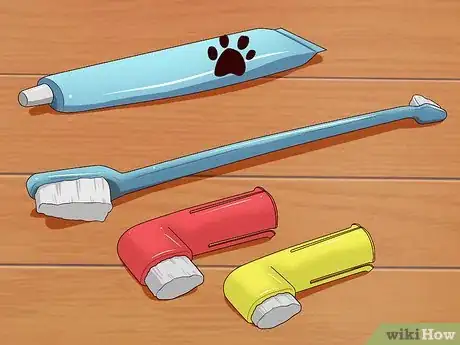
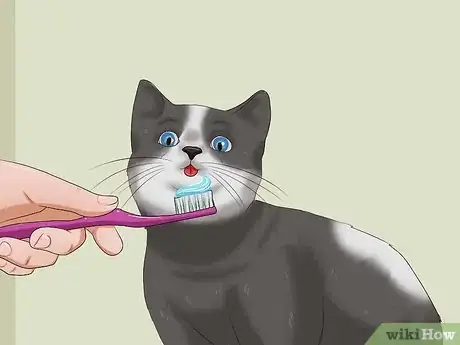
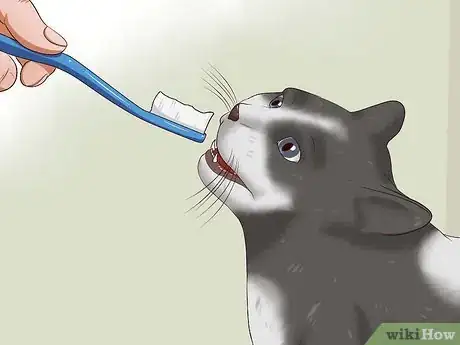


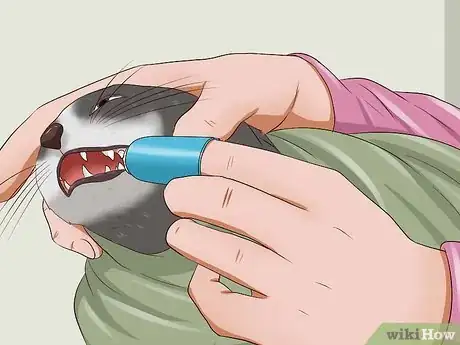
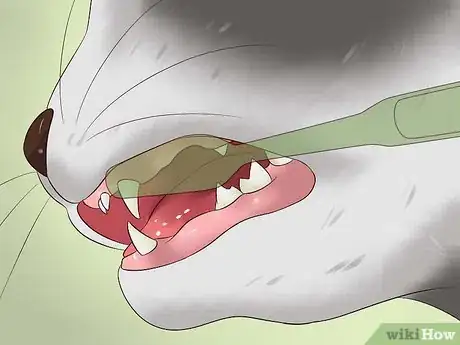
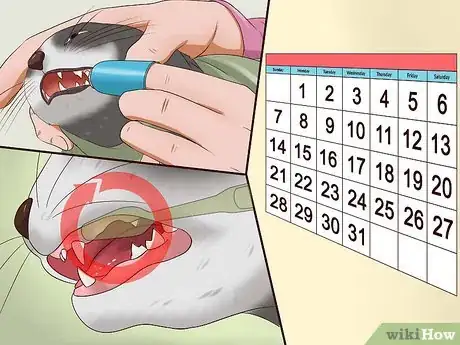

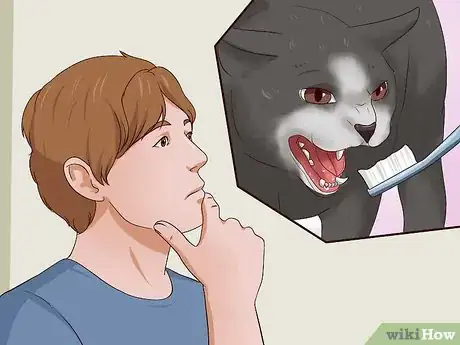
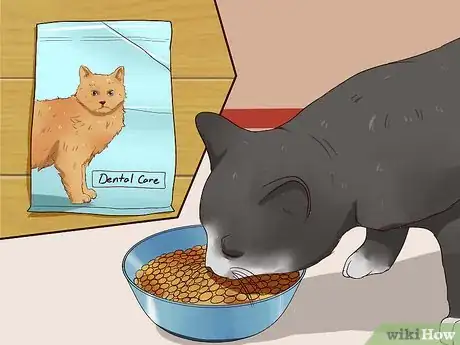
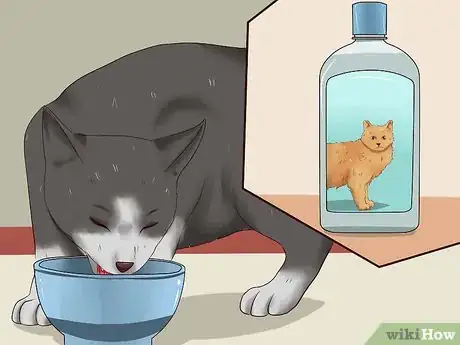
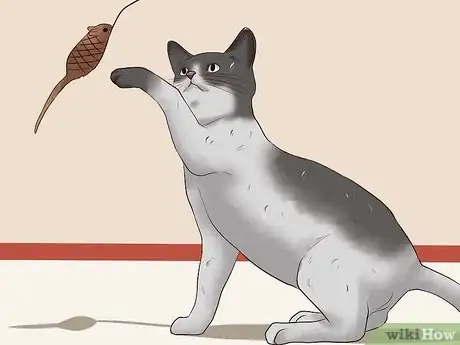
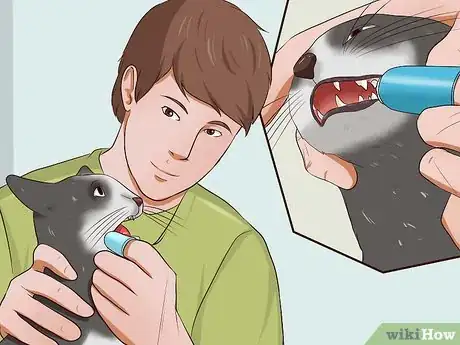
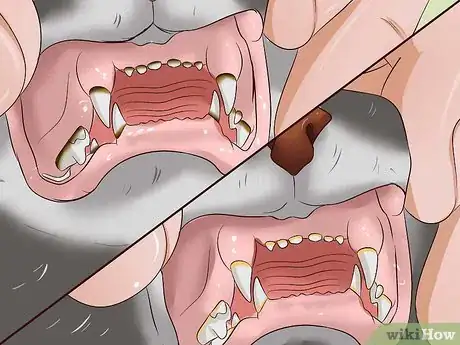

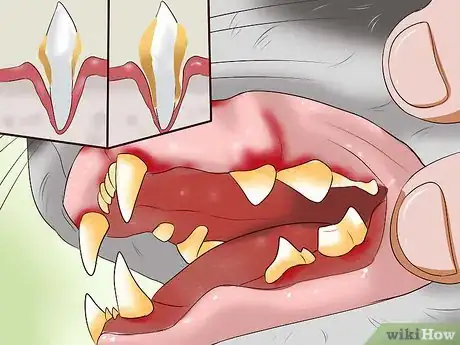
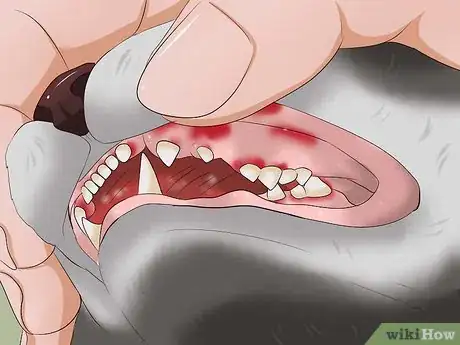
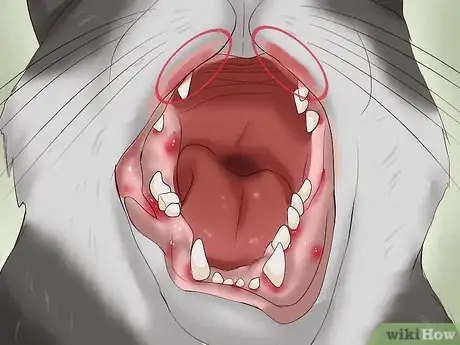
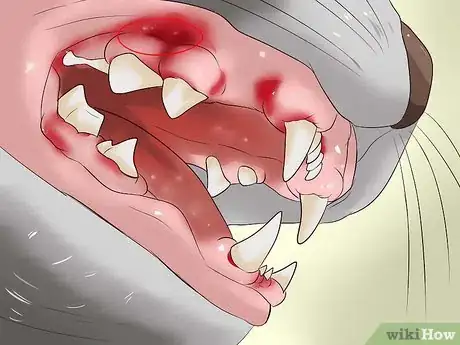
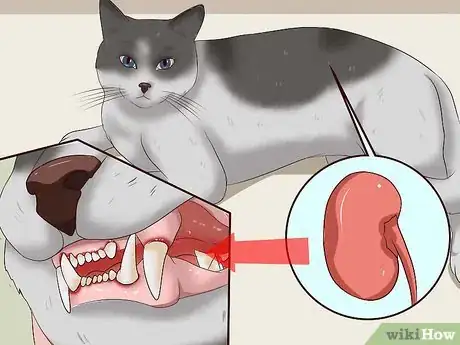
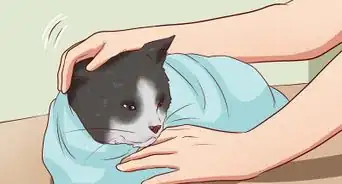
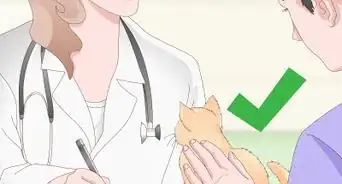
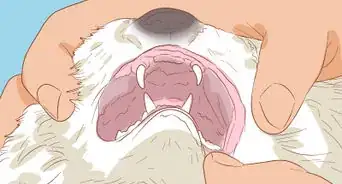
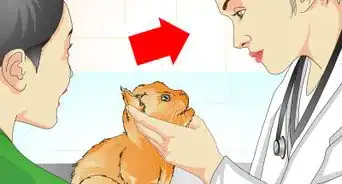

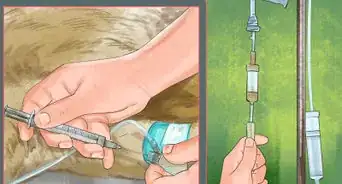
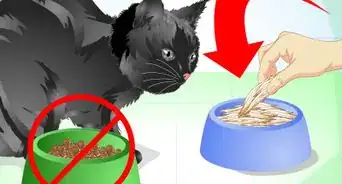











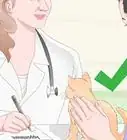

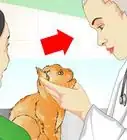



































Medical Disclaimer
The content of this article is not intended to be a substitute for professional medical advice, examination, diagnosis, or treatment. You should always contact your doctor or other qualified healthcare professional before starting, changing, or stopping any kind of health treatment.
Read More...